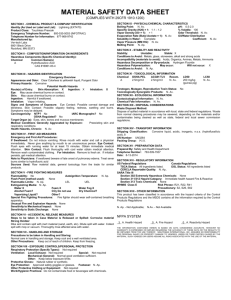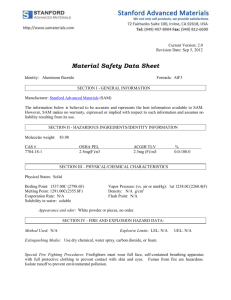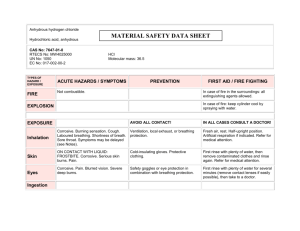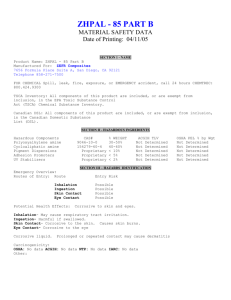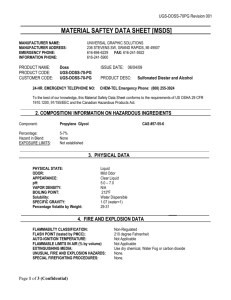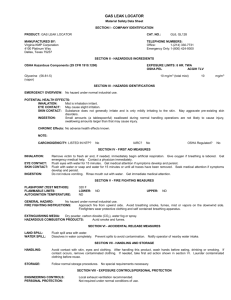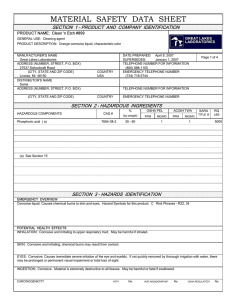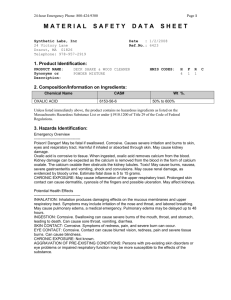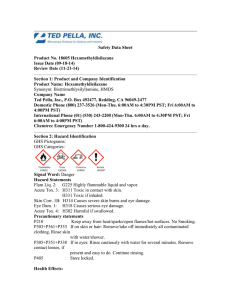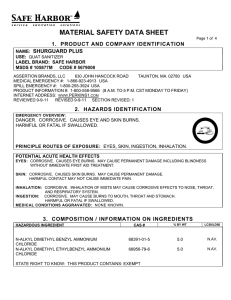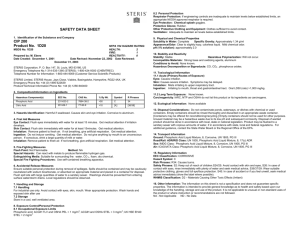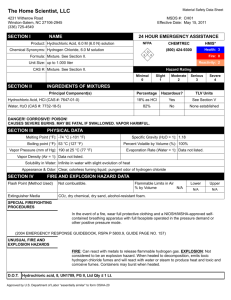MSDS - Advantage Coatings & Cleaners
advertisement
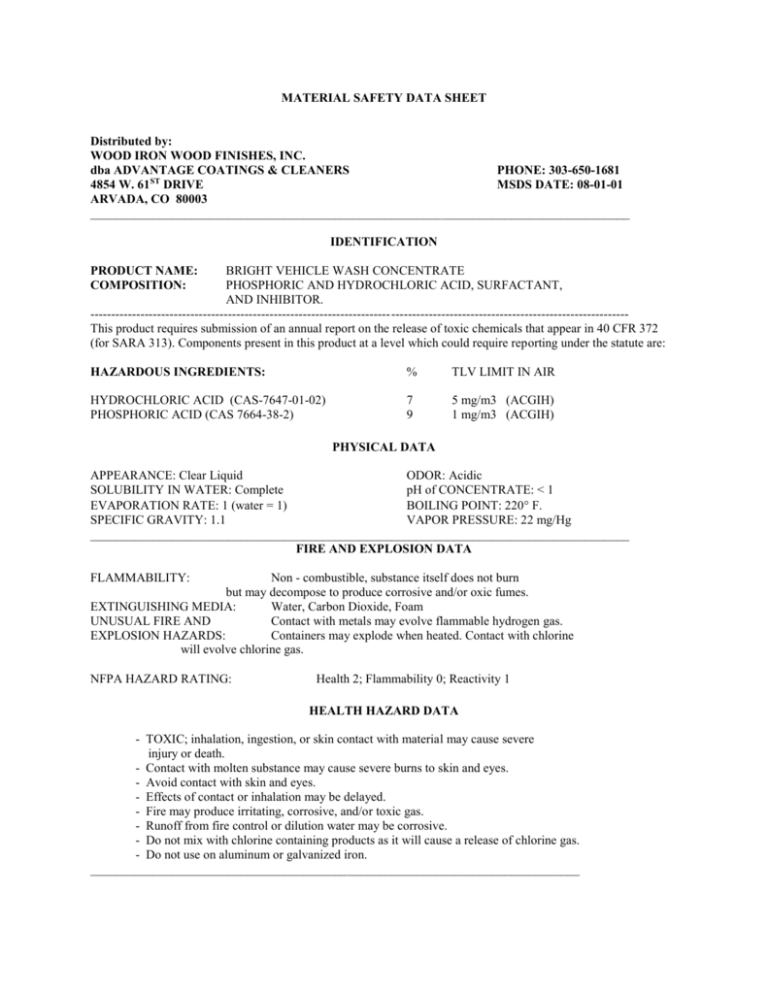
MATERIAL SAFETY DATA SHEET Distributed by: WOOD IRON WOOD FINISHES, INC. dba ADVANTAGE COATINGS & CLEANERS PHONE: 303-650-1681 4854 W. 61ST DRIVE MSDS DATE: 08-01-01 ARVADA, CO 80003 ______________________________________________________________________________________ IDENTIFICATION PRODUCT NAME: COMPOSITION: BRIGHT VEHICLE WASH CONCENTRATE PHOSPHORIC AND HYDROCHLORIC ACID, SURFACTANT, AND INHIBITOR. --------------------------------------------------------------------------------------------------------------------------------This product requires submission of an annual report on the release of toxic chemicals that appear in 40 CFR 372 (for SARA 313). Components present in this product at a level which could require reporting under the statute are: HAZARDOUS INGREDIENTS: % TLV LIMIT IN AIR HYDROCHLORIC ACID (CAS-7647-01-02) PHOSPHORIC ACID (CAS 7664-38-2) 7 9 5 mg/m3 (ACGIH) 1 mg/m3 (ACGIH) PHYSICAL DATA APPEARANCE: Clear Liquid ODOR: Acidic SOLUBILITY IN WATER: Complete pH of CONCENTRATE: < 1 EVAPORATION RATE: 1 (water = 1) BOILING POINT: 220 F. SPECIFIC GRAVITY: 1.1 VAPOR PRESSURE: 22 mg/Hg ______________________________________________________________________________________ FIRE AND EXPLOSION DATA FLAMMABILITY: Non - combustible, substance itself does not burn but may decompose to produce corrosive and/or oxic fumes. EXTINGUISHING MEDIA: Water, Carbon Dioxide, Foam UNUSUAL FIRE AND Contact with metals may evolve flammable hydrogen gas. EXPLOSION HAZARDS: Containers may explode when heated. Contact with chlorine will evolve chlorine gas. NFPA HAZARD RATING: Health 2; Flammability 0; Reactivity 1 HEALTH HAZARD DATA - TOXIC; inhalation, ingestion, or skin contact with material may cause severe injury or death. - Contact with molten substance may cause severe burns to skin and eyes. - Avoid contact with skin and eyes. - Effects of contact or inhalation may be delayed. - Fire may produce irritating, corrosive, and/or toxic gas. - Runoff from fire control or dilution water may be corrosive. - Do not mix with chlorine containing products as it will cause a release of chlorine gas. - Do not use on aluminum or galvanized iron. ______________________________________________________________________________ Page 2 BRIGHT Vehicle Wash EMERGENCY & FIRST AID PROCEDURES EYE CONTACT: Flush with cool running water for at least 15 minutes. For eye exposure irrigate with saline solution. Get medical attention as soon as possible. SKIN CONTACT: Flush with cool running water. If irritation develops get medical attention. INGESTION: If conscious, give several glasses of milk or water, followed by Milk of Magnesia, olive oil, beaten egg whites or gelatin solution. Get medical attention immediately. DO NOT induce vomiting. INHALATION: Move victim to fresh air. Call emergency medical care. Apply artificial artificial respiration if victim is not breathing. ______________________________________________________________________________________ SPECIAL PROTECTION INFORMATION RESPIRATORY PROTECTION: VENTILATION SYSTEM: SKIN PROTECTION: EYE PROTECTION: PROTECTIVE GLOVES: Atmospheric levels should be maintained below the exposure limits Listed in Hazardous Ingredients by using engineering controls. If not feasible, Use approved full face-piece air-purifying respirator. Provide general and/or local exhaust ventilation to maintain airborne levels below the exposure limits in Hazardous Ingredients. Refer to “Industrial Ventilation” by ACGIH for a manual of recommended practices. If skin or contamination of clothing is likely, protective clothing should be worn. Chemical goggles are required. Wear chemical resistant gloves. ______________________________________________________________________________________ REACTIVITY DATA INCOMPATIBLE MATERIALS: Alkalis, chlorinated products, soft metals, organic compounds. STABILITY: Product is stable. POLYMERIZATION: Will not occur. DECOMPOSITION PRODUCTS: May give off phosphorous oxide or hydrogen gas at high heat (fire conditions). ______________________________________________________________________________________ SPILL OR LEAK PROCEDURES SPILL: See Emergency/ First Aid Procedures and Special Protection Information for hazards and exposure controls. Dike with sand or earth to contain spill. Avoid ignition sources. Absorb with sand to other non-flammable material and transfer to approve DOT drum for recovery or disposal. DISPOSAL: Dispose of in accordance with local, state and federal regulations. GENERAL: CERCLA/SARA requires notification to the appropriate Federal state and local authorities of releases of hazardous or extremely hazardous quantities equal to or greater than the Reportable Quantities (RQs) in 50 CFR 302.4 and 40 CFR 355. SARA Title 313 requires submissions of annual reports of releases of toxic chemicals that appear in 40 CFR 372. Components present in this product at a level which could require reporting under statute are listed under identification. ________________________________________________________________________________________________ TRANSPORTATION DOT HAZARD CLASSIFICATION: Corrosive Liquid, Acidic, Inorganic, N.O.S. 8, UN3264, PG II US DOT LABEL: Corrosive, UN3264, Class 8 PLACARD REQUIRED Corrosive, Class 8, Label as required by OSHA Hazard OVER 1,000 LBS: Communication Standard, and any applicable state and local regulations. Prepared By: Charlie Talley, Five Star Chemical EMERGENCY TELEPHONE: INFOTRAC 800-535-5053
